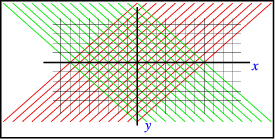
I have argued before that it is usually not useful to study the general solution of a partial differential equation. As any such sweeping statement it needs to be qualified, since there are some exceptions. One of these is the one-dimensional wave equation
|
{{∂}^{2}u\over
∂{x}^{2}}(x,t) − {1\over {
c}^{2}} {{∂}^{2}u\over
∂{t}^{2}} (x,t) = 0,
| (6.1) |
which has a general solution, due to the French mathematician d’Alembert.
The reason for this solution becomes obvious when we consider the physics of the problem: The wave equation describes waves that propagate with the speed c (the speed of sound, or light, or whatever). Thus any perturbation to the one dimensional medium will propagate either right- or leftwards with such a speed. This means that we would expect the solutions to propagate along the characteristics x ± ct = \text{constant}, as seen in Fig. 6.1.